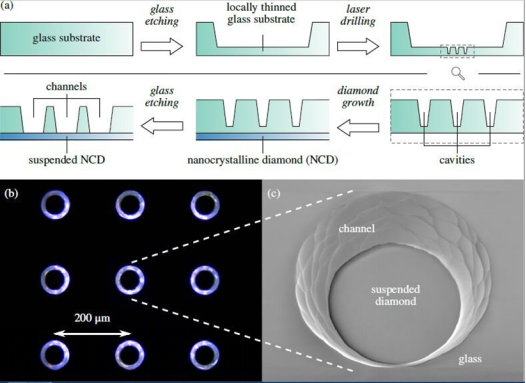Company tel:+86-379-63184520
Contact number:+86-15937921751
Postcode:471000
Email:info@yuxindiamond.com
Address:3-1-508 Luoyang National University Science Park, No. 2 Penglai Road, Jianxi District, Luoyang, China 471000
Diamonds Are Forever:New Foundation For Nanostructures
Devices smaller than the width of a human hair are key to technologies for drug delivery,semiconductors,and fuel production.But current methods for fabricating these micro-and nanostructures can be expensive and wasteful.
Researchers at the Okinawa Institute of Science and Technology Graduate University(OIST)have fabricated a novel glass and synthetic diamond foundation that can be used to create miniscule micro-and nanostructures.This new substrate is low cost and leaves minimal waste,the researchers say,in a study published in Diamond and Related Materials.
"We've spent the last couple of decades throwing away plastics,"said Stoffel Janssens,the first author of the study,and a member of OIST's Mathematics,Mechanics,and Materials Unit."With sustainable materials like diamond and glass,we're minimizing negative environmental impacts."
Building a Nanostructure

Current processes in place for micro-and nanodevice fabrication can be costly and inefficient.Synthetic diamond,which has the same chemical structure as natural diamond,is resilient,low-cost and sustainable,and glass is versatile and electrically insulating;technologies that combine the two are promising.
The researchers made their foundation using glass etching,a process that relies on acid to reduce a glass slab to a thickness of 50 micrometers(about the length of a typical cell in the human body).Janssens and his collaborators,Professor Eliot Fried,David Vázquez-Cortés,Alessandro Giussani,and James Kwiecinski,used a laser to drill cavities,approximately 40 micrometers in diameter and depth,into one side of the glass slab.
Next,the scientists grew a 175-nanometer thick nanocrystalline diamond film on the other side of the glass and transformed the drilled cavities into small channels sealed with suspended diamond.Combining diamond and glass creates a transparent structure in which scientists can grow and visualize living cells.
"During this fabrication process,the glass can easily become rough and opaque,"said Janssens."There are so many small things that can go wrong;we made many adjustments to optimize our process."
Moving forward,Janssens hopes to create porous diamond films tailored to deliver specific drugs.The researchers have filed a patent for the new foundation and are exploring its commercial potential.
"This type of research can only be done through the combined efforts of researchers with different backgrounds,"said Fried."The interdisciplinarity of OIST and its collaborative environment made our work possible."
Diamond,as one of the most special materials in natural world,is featured with the highest hardness,low friction coefficient,high elasticity modulus,high thermal conductivity,high insulation class,wide energy gap,great sound propagation rate and favorable chemical stability,which are presented in below Table.In spite of such unique features,the natural diamond has always been existed in the form of gem,with its variability and rareness sharply limiting its application.Luoyang Yuxin Diamond Co.,Ltd‘s CVD Diamond film,on the other hand,integrates such physical and chemical properties,with lower cost than natural diamond and applicable to be made into various shapes,thus enjoying extensive application prospect in electronic industry,optical field and mechanical industry.







